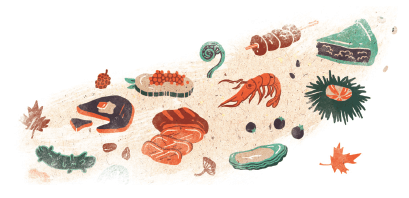Not your grandma’s poutine
Hana Shafi
Meet the foodies on the hunt to redefine Canadian cuisine
Anita Stewart has spent more than 30 years travelling across Canada, all in the name of food. In B.C., Stewart scuba-dived off the coast of southern Vancouver Island to see sea cucumbers and urchins. On the edges of the east coast, she tried everything from caviar to moonshine. And in the prairies, Stewart tasted sweet Saskatoon berry pies, bison meat, and everything in between. Through all these culinary adventures, Stewart searched for the answer to one, elusive question: What is Canadian cuisine?
When Stewart began her journey in the in the 1980s she says, there was a real sense Canadian cuisine didn’t exist—or, at least, nobody was calling it that. “It was really an oxymoron,” she quips. But now, embracing Canadian cuisine has become a movement, even a form of activism, with chefs, farmers, and bloggers from all across the country advocating for Canadian cuisine to be promoted and celebrated. These days, Stewart bristles at the suggestion Canadian cuisine isn’t actually a thing. If Canadian cuisine doesn’t exist, she says, then neither does Italian. “A cuisine is the way a people eat,” she adds. “It’s the product of a people and a place and the ingredients.”
Still, ask Canadians and non-Canadians alike to name our nation’s food and many are likely to respond with the stereotypical: poutine, beavertails, maple syrup—perhaps Tim Hortons. Stewart says she doesn’t care if people want to argue over the minutia of whether a poutine is Canadian; she defines Canadian cuisine as one of possibilities. That is, a diverse spectrum of local, regional and national ingredients that come together to create unique dishes—one that celebrate the huge variety of ingredients that Canada has to offer.
Stewart has written 11 books and co-authored another three. Her most recent book Canada: The Food, The Recipes, The Stories, published in 2008 but reprinted in Spring 2013, is an extensive compilation of recipes from across Canada, and from all the cultures of Canada. Recipes focus on the importance of local fresh ingredients (rather than a small handful of dishes to “represent” Canada). Diversity is celebrated: Ukrainian, Indian, Scottish and French recipes, for example, are included, spanning from Red Shoes gingerbread to lamb and from prune tagine (a Moroccan dish) to grilled pacific halibut garnished with Indian-spiced yogurt.
Such variety doesn’t surprise New Brunswick-based Christina Allain, a food activist and blogger who specializes in Acadian cuisine. Even culinary choices within Acadian cuisine vary vastly from region to region, she says, and that’s just one subculture. “We’re the contrary of a homogenous group,” she adds. “You look at Acadia and
all the differences in the region; they blow up when you look at all of Canada.” Like much of Canadian cuisine, Acadian food has been heavily shaped by relying on regional ingredients. Whatever grew in the area became a central part of the food—one reason why seafood is so prominent.
Allain’s favourite recipe is Acadian chicken fricot, which she describes as “a hearty stew containing potatoes, dumplings, chicken, and summer savoury.” Allain adds that a dish like chicken fricot can be reinvented depending on where the cook is located in Canada and what seasonal ingredients are available.
Let’s not forget the role of pre-colonial food, either. Indigenous cuisine is anything but new—you could call it the original food of Canada, produced centuries before our legal independence as a country in 1867. Yet unlike other historical comeback foods, such as Acadian cuisine, indigenous dishes are rarely available in restaurants, and there is no sense they’ve become popularized in grocery stores. Like with the broader Canadian cuisine conundrum, indigenous food is hard to define. Despite stereotypes that would limit it to bannock, indigenous cuisines across Canada are both diverse and largely dependent on the geography and natural vegetation of the region.
Rich Francis is an aboriginal chef (his father is Tetlit Gwich’in and his mother is Tuscarora). He’s currently working on perfecting his own restaurant, District Red, which specializes in indigenous cuisine. He’s also a Season 4 Top Chef Canada finalist. His focus is on pre-contact indigenous food—dishes that existed before European colonizers came to the land North America. First Nations food, from post-contact right up to today, says Francis, is perceived as both bland and boring— largely because it was a colonized diet given to First Nations. Much of the original tradition and culture was lost in that colonization, he adds. But that’s changing.
Francis hopes District Red will help bring indigenous foods to mainstream cuisine in Canada. “The ways I achieve this is by going back to before pre-contact,” says Francis, “utilizing what’s been given to us through tradition, culture and storytelling.” Francis wants to add his “personal touch, fearless creativity, and modern cooking technique”
to traditional indigenous foods, without feeling constricted by labeling his food as Canadian.
When I later ask Stewart how she would explain Canadian cuisine to someone who’s not from Canada, she says she’d tell them to get in the car, start driving, and eat their way across the country. Though a cross-country road trip may not be exactly practical, Stewart has a point. Maybe that’s what Canadian cuisine is: not a few iconic dishes, but a constant exploration of foods and people—a cross-country journey of flavours and histories that make up an entire nation’s cuisine. “If we squander our food tradition, and we turn our back our own products, then we turn our backs on our history, because food is the basis of everything,” says Stewart. “All I know is we’re cooking really good food in Canada and have for a long time.”
